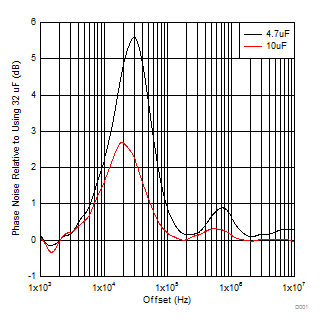ZHCSD96G August 2012 – September 2014 LMX2581
PRODUCTION DATA.
- 1 特性
- 2 应用
- 3 说明
- 4 简化电路原理图
- 5 修订历史记录
- 6 Pin Configuration and Functions
- 7 Specifications
-
8 Detailed Description
- 8.1 Overview
- 8.2 Functional Block Diagram
- 8.3
Feature Description
- 8.3.1 Typical Performance Characteristics
- 8.3.2 Impact of Temperature on VCO Phase Noise
- 8.3.3 OSCin INPUT and OSCin Doubler
- 8.3.4 R Divider
- 8.3.5 PLL N Divider And Fractional Circuitry
- 8.3.6 PLL Phase Detector and Charge Pump
- 8.3.7 External Loop Filter
- 8.3.8 Low Noise, Fully Integrated VCO
- 8.3.9 Programmable VCO Divider
- 8.3.10 0-Delay Mode
- 8.3.11 Programmable RF Output Buffers
- 8.3.12 Fastlock
- 8.3.13 Lock Detect
- 8.3.14 Part ID and Register Readback
- 8.3.15 Optimization of Spurs
- 8.4 Device Functional Modes
- 8.5 Programming
- 8.6
Register Maps
- 8.6.1
Programming Word Descriptions
- 8.6.1.1 Register R15
- 8.6.1.2 Register R13
- 8.6.1.3 Registers R10, R9, and R8
- 8.6.1.4 Register R7
- 8.6.1.5 Register R6
- 8.6.1.6
Register R5
- 8.6.1.6.1 OUT_LDEN — Mute Outputs Based on Lock Detect
- 8.6.1.6.2 OSC_FREQ[2:0] — OSCin Frequency for VCO Calibration
- 8.6.1.6.3 BUFEN_DIS - Disable for the BUFEN Pin
- 8.6.1.6.4 VCO_SEL_MODE — Method of Selecting Internal VCO Core
- 8.6.1.6.5 OUTB_MUX — Mux for RFoutB
- 8.6.1.6.6 OUTA_MUX — Mux for RFoutA
- 8.6.1.6.7 0_DLY - Zero Delay Mode
- 8.6.1.6.8 MODE[1:0] — Operating Mode
- 8.6.1.6.9 PWDN_MODE - Powerdown Mode
- 8.6.1.6.10 RESET - Register Reset
- 8.6.1.7 Register R4
- 8.6.1.8 Register R3
- 8.6.1.9 Register R2
- 8.6.1.10 Register R1
- 8.6.1.11 Register R0
- 8.6.1
Programming Word Descriptions
- 9 Application and Implementation
- 10Power Supply Recommendations
- 11Layout
- 12器件和文档支持
- 13机械封装和可订购信息
10 Power Supply Recommendations
10.1 Supply Recommendations
Low noise regulators are generally recommended for the supply pins. It is OK to have one regulator supply the part, although it is best to put individual bypassing as shown in the Layout Guidelines for the best spur performance. The most noise sensitive components are the pull-up components for the output buffers since supply noise here will directly go to the output. For purposes of bypassing, below is how the current consumption is approximately distributed through each pin. For this table, default mode is with internal VCO mode with one output buffer powered up with OUTx_PWR=15. External VCO mode assumes the VCO divider and output buffers are off.
Table 16. Current Consumption by Pin
| PIN NUMBER | PIN NAME | CONDITION | ||
|---|---|---|---|---|
| DEFAULT MODE | DEFAULT MODE with VCO DIVIDER ENABLED |
EXTERNAL VCO MODE with OUTPUT BUFFER DISABLED |
||
| Pin 6 | VccCP | 12 | 12 | 12 |
| Pin 10 | VccPLL | 28 | 28 | 48 |
| Pin 16 | VccBUF | 23 | 43 | 1 |
| Pin 17 | VccVCO | 83 | 83 | 14 |
| Pin 28 | VccDIG | 10 | 10 | 10 |
| Pin 32 | VccFRAC | <<1 | <<1 | <<1 |
| n/a | Output Pull-Up Component | 22 | 22 | 0 |
| TOTAL | 178 | 198 | 85 | |
10.2 Regulator Output Pins
The recommendation for the VregVCO and VbiasCOMP pins is a minimum of one 10 µF capacitor, but more capacitance is better. These pins have a bias voltage of about 2.5 V, which means that capacitors of smaller case size and voltage ratings can actually have far less capacitance the labeled value of the capacitor. If there is insufficient capacitance on these pins, then the VCO phase noise may be degraded. This degradation may vary with frequency and how insufficient the capacitance is, but for example, bench tests show a degradation of about 5 dB at 20 KHz offset for a 3 GHz carrier if these capacitors are reduced to 4.7 µF.
 Figure 26. Impact of VregVCO and VbiasCOMP Capacitor on VCO Phase Noise
Figure 26. Impact of VregVCO and VbiasCOMP Capacitor on VCO Phase Noise